Descubren material de momificación dentro de un sarcófago de 3.000 años en Egipto
El ataúd pertenece a la primera tumba hallada en el Valle de los Reyes en 80 años, destapada hoy. Una nueva tumba ha sido descubierta en el Valle de los Reyes, en Egipto, por primera vez en 80 años. (AP)
Arqueólogos estadounidenses y egipcios destaparon hoy completamente la primera tumba descubierta en el Valle de los Reyes, en Luxor, en más de 80 años. Tras abrir el último de los siete sarcófagos que encontraron en su interior, los expertos hallaron materiales usados en la momificación, así como joyas y objetos personales. El sarcófago pertenece a la XVIII dinastía faraónica (1550-1292 a. C.).
"Esto es inclusive mejor que encontrar una momia: es un tesoro", dijo Nadia Lokma, una de las arqueólogas del Valle de los Reyes frente al sarcófago. El ataúd está repleto de restos frágiles que podrían convertirse en polvo si se los toca.
La tumba "informará de las plantas y hierbas usadas por los antiguos egipcios: qué vestían, cómo tejían su ropa, cómo embalsamaban a sus muertos", dijo. La tumba, enterrada en roca blanca, fue descubierta de manera accidental el año pasado por arqueólogos estadounidenses que trabajaban en la vecina tumba de Amenmeses, un faraón de la 19 dinastía egipcia. Se cree que la tumba tiene más de 3.000 años de antigüedad.
Los científicos descubrieron la tumba en febrero, tras abrir un boquete en la puerta del sepulcro; pero hoy fue la primera vez que investigadores y periodistas pudieron recorrer el sitio, de 2,5 metros de ancho por 4,5 metros de largo. Varios arqueólogos abrieron el último de los siete sarcófagos encontrados en la tumba. El sarcófago no contenía una momia, como es habitual, sino materiales para preservar cadáveres, decenas de collares hechos con flores entretejidas, y varios artefactos religiosos.
Cubiertos en moldes de resina que mostraban el rostro de sus dueños, los siete ataúdes no contenían cuerpos en su interior. En lugar de momias, fueron hallados numerosos trozos de cerámica. Un pequeño sarcófago, destinado a un niño, contenía almohadas que parecían llenas de plumas. Lokma expresó su esperanza de que los jeroglíficos ayuden a los científicos a identificar a quiénes estaban destinados los sarcófagos y, tal vez, dónde fueron enterrados finalmente los cuerpos.
El descubrimiento de la tumba el año pasado puso fin a la hipótesis que no hay ya nada más que excavar en el Valle de los Reyes, la región desértica cercana a la ciudad sureña de Luxor. El valle fue utilizado para enterrar faraones, reinas, y nobles entre los años 1.500 y 1.000 antes de Cristo.
Fuente: El País.es, 29 de junio de 2006
Enlace: http://www.elpais.es/articulo/cultura/Descubren/material/momificacion
/dentro/sarcofago/000/anos/Egipto/elpporcul/20060629elpepucul_1/Tes/
(2) No mummy in Valley of the Kings tomb but mystery remains whole
CAIRO (AFP) - The first tomb discovered in Luxors Valley of the Kings did not reveal its expected mummy, but egyptologists remained bent on cracking the mystery of "KV 63."
Three thousand year-old flowers and royal necklaces were the only things Egypts chief archeologist Zahi Hawass saw when he lifted the lid off the last of seven coffins found in the tomb.
"Its superb but there is no room for a mummy," said Otto Schaden, the America archeologist who uncovered the tomb almost by chance in February, only a few feet away from "KV 62" -- the famous sepulchre of King Tut.
The six other coffins contained pottery shards, and the team of Egyptian and US archeologist working on the site had to conceal their disappointment after much anticipation that the last coffin might contain a royal mummy.
But they vowed to continue their research and reveal the origin of this tomb, which is niched in a cliff of the pharaonic necropolis and has been dubbed "KV63."
The flambloyant Hawass even risked a theory.
"I do believe that it could be for the mother of King Tut. Its a theory. But I believe King Tut came here to be buried beside her, because maybe its the tomb of his mother," he told AFP.
"No mummy ... but im sure we will find very interesting elements underneath, maybe tools," added Nadia Lukma, a senior archeologist at Cairo Museum.
When Schaden and his team from Memphis University uncovered the tomb, burried under several feet of rubble, the world or archeology held its breath.
No tomb had been found in more than more than 80 years in this arid complex west of the ancient city of Thebes where three dynasties of Sun kings and their relatives had their tombs dug into the rock.
"Although there is no mummy here, there are strong indications that this tomb is linked to Tuts, with elements relating to the cult of Aten and Amon," Otto Schaden said.
Aten was the sun god, considered a creator of the universe in ancient Egyptian mythology, whose worship was the basis of the religion instituted by Akhenaten, thought to be Tuts father.
Hawass was more assertive. "I can rule out that this is linked to (Tuts) widow" Ankhesenamun, he said. "But why not to his mother, who could be Nefertiti?"
The identity of Tuts mother remains more mysterious than his fathers, with some theories identifying her as Nefertiti and others as Kiya, a foreign princess, or even his wet nurse Maya.
Tut, the boy king who died at the age 18, rejected his fathers "heretical" monotheistic religion and returned to the traditional worship of many gods.
"Now Shaden and his team have to carefully study, maybe after taking the resin out of the last coffin they will be able to read some of the letters, because there are no complete words, and get accurate information to prove who was the owner of the tomb," Hawass explained.
The archeologists have a collection of pieces of linen, flowers, 28 earthenware urns and other objects to analyse before they can break the secret of KV63.
"Many tombs were opened in the past, hundred of mummies were found but now, opening that coffin, we found for the fist time a kind of material that they used after mummification like large very decorative necklaces and flowers," Hawass said.
Schaden explained that clues would probably have to come from the coffins themselves as the tomb appeared to have been looted some 1,300 before Christ and the caskets were most likely moved around from one location to another.
Fuente: Alain Navarro / AFP, 28 de junio de 2006
Enlace: http://news.yahoo.com/s/afp/20060628/wl_mideast_afp/
egyptarcheology_060628182128;_ylt=AhfJzvMhvNL1QVkTJ
EkIJJRxieAA;_ylu=X3oDMTA2ZGZwam4yBHNlYwNmYw--
Reportaje Fotográfico:
An unidentified worker of the Egyptian excavation team looks on next to a Sarcophagus found inside tomb KV63 at Egypts Valley of the Kings, outside Luxor, Egypt Wednesday, June 28, 2006. Archeologists unveiled Wednesday the first tomb discovered in over 80 years in the massive Valley of the Kings burial site where dozens of Egyptian pharaohs were laid to rest among their wives, children and courtesans. (AP Photo/Alfred De Montesquiou )
Egyptian Archaeologists Amani Emile and Ahmad Bagdadi brush the wooden cover of a sarcophagus recently discovered in a tomb in the Valley of the Kings on Luxors West Bank. The first tomb discovered in Luxors Valley of the Kings did not reveal its expected mummy, but egyptologists remained bent on cracking the mystery of "KV 63."(AFP/Khaled Desouki)
Egyptologist Nadia Lokma points with a torch light to one of the sarcophagi recently discovered in a tomb in the Valley of the Kings on Luxors West Bank. The first tomb discovered in Luxors Valley of the Kings did not reveal its expected mummy, but egyptologists remained bent on cracking the mystery of "KV 63."(AFP/Khaled Desouki)
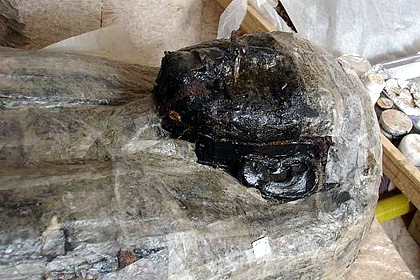
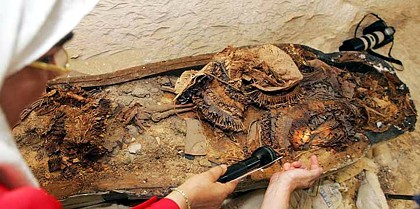
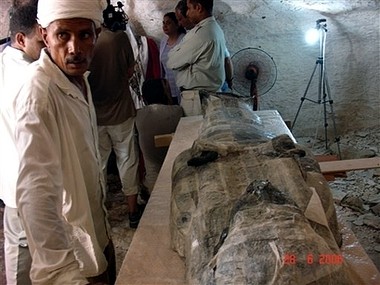
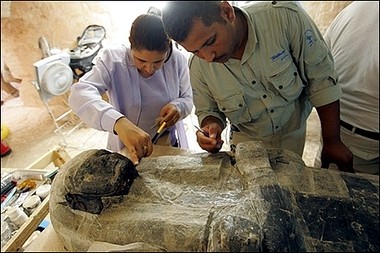
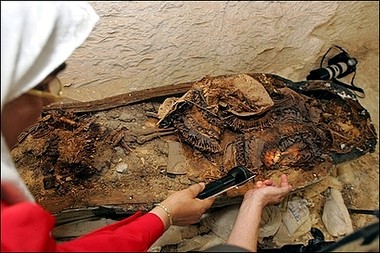
2 comentarios
gabriela y damian -
manuel rodriguez -